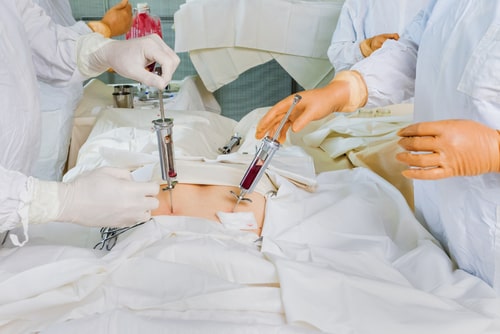
Children and Bone Marrow Transplants
Sagarika (name changed) sits in the paediatric ward of Medanta – The Medicity, playing with her toys on the bed. She looks up, smiles and waves every time a nurse or doctor passes by. According to her mother, four-year-old Sagarika is every bit naughty and playful like children her age and if you don’t bother looking too hard, you might even miss the intravenous tube present on her hand.
Sagarika was born with Thalassemia Major – a blood disorder where haemoglobin and red blood cells are fewer than normal. For Sagarika, if not for a monthly blood transfusion for the rest of her life, a bone marrow transplant (BMT) is the only option.
Bone Marrow Transplant

Bone marrow is the soft, fatty tissue inside the bones and is extremely vital because it produces red blood cells, white blood cells and platelets - all components of blood needed in the body. It is also home to the body’s immune system.
A bone marrow transplant or stem cell transplant is performed when the defective or damaged bone marrow does not produce these blood cells and needs to be replaced with healthy bone marrow stem cells either from the patient’s own body (autologous BMT) or from a donor (allogeneic BMT).
In autologous BMT, the child is their own stem cell donor. Autologous BMT is used to replace stem cells that have been damaged by high doses of chemotherapy, used to treat the child’s disease. Blood cells or bone marrow is collected in advance (while they are in remission) and put back into the child at a later stage.
In Allogeneic BMT, another person’s cells are used for the child. In the best-case scenario, this donor should genetically match the child needing it by the HLA Typing test. However today, doctors have mastered the technique of even ‘half-matched’ transplants where just 50 per cent‘ human leukocyte antigen or HLA’ matches with the child. Parents are almost always a 50 per cent match. Sometimes, siblings, uncles and aunts can also be a half match with the child.
A bone marrow transplant is needed when children are born or detected with various disorders like:
- Thalassemia: Doctors say that about 10,000-12,000 children are born every year in India with beta-thalassemia major, an inherited blood disorder. Every individual carries two beta chains in the blood; one comes from the mother and the other from the father. If one chain is affected, the child is diagnosed with Thalassemia Minor and is absolutely normal except for mild anaemia sometimes. But if both the beta chains are affected then the child is diagnosed with Thalassemia Major and needs a blood transfusion every month, throughout their life span. The only curative option for Thalassemia Major is a bone marrow transplant.
- Leukaemia: Leukaemia is the cancer of white blood cells and is said to be one of the commonest cancers detected in children. Chemotherapy is the first line of treatment but for high-risk leukaemia, which fails to respond to treatment or which relapses even after appropriate treatment, BMT is the treatment of choice.
- Solid Tumours: For solid tumours like brain tumours (Medulloblastoma), high-risk Neuroblastoma, relapsed Retinoblastoma, children need high doses of chemotherapy or radiotherapy for their treatment. But at such high doses, the bone marrow stops functioning. BMT is done to restore the marrow function.
- Aplastic Anaemia (Bone Marrow Failure): Children develop Aplastic Anaemia when the bone marrow slows or does not produce new blood cells. This can be caused as a reaction to infections, certain medications or as a side effect to cancer treatment. If a fully matched sibling donor is available, then BMT is the best treatment option.
- Sickle Cell Anaemia: When red blood cells are in the shape of sickles (instead of being rounded) and become rigid and sticky, the child is detected with Sickle Cell Anaemia or Sickle Cell disease. These misshapen blood cells are known to get stuck in the bloodstream and prevent the free flow of blood throughout the body. Nearly 30,000 children are born with Sickle Cell Anaemia every year in India. Replacing these blood cells through a BMT is the only way to cure children with this disorder.
- Immune Disorders: Immune disorders are genetically inherited and lead to increased susceptibility to infections in the individual. These children are deficient in one or more cells that are necessary for a normal immune mechanism of the body. Due to the absence of a normal immune system, these children are susceptible to severe infections that cause recurrent health problems, and most children die at an early age. With BMT, a new immune system is created in their body which helps them fight illnesses like normal people and live a long healthy life.
- Genetic Disorders (Inborn Errors of Metabolism): Genetic disorders are caused by a deficiency of a particular substance in the body, generally an enzyme. This leads to an accumulation of toxic chemicals inside the cells causing tissue damage and even organ failure. A bone marrow stem cell transplant helps provide special cells, which travel to various organs and provide missing enzymes to counter the damage. Diseases like Hurler Syndrome, Hunter Syndrome, Gaucher Disease can be cured by BMT.
Side-effects of Bone Marrow Transplants
Like with cancer patients receiving chemotherapy, a bone marrow transplant has its share of short-term and long-term side effects.
- Infections: When BMT needs to be done, the child receives high doses of chemotherapy or radiation therapy to destroy their diseased bone marrow. After that blood-forming stem cells are transplanted into their body, to help rebuild new bone marrow. The interim period between destroying the old bone marrow and the new marrow adapting in the body is said to be a highly precarious time for the child as they become prone to a lot of infections. During such a time, any severe infection can be fatal.
- Graft Vs Host Disease (GVHD): In GVHD there is a chance that the donor immune cells can attack the child’s body when the transplant is received from a donor. This means the donated cells start attacking the child’s body especially the skin, liver and gut. If not controlled with medicines, it can be dangerous.
- Fertility: Due to chemotherapy exposure during BMT, most children have the risk of losing fertility.
Right Care at the Right Time and Place
Medanta’s Paediatric Bone Marrow Transplant programme is one of the premier institutes that treats children with blood disorders and cancers. The hospital has:
- A team of doctors: Who have performed hundreds of transplants, mainly in the paediatric age group. These include doing half-matched donor transplants as well.
- A special wing for BMT patients: Each of these rooms has air filters (known as HEPA filters) and positive air pressure to keep infections out of the room.
- Dedicated nursing: There is a 1:1 ratio with nurses specially trained to handle immunocompromised patients.
- State of the art blood bank: BMT patients need a constant supply of blood and its various components. The blood bank at Medanta is capable of providing all kinds of blood products. Even the stem cell harvesting is done by experienced doctors in-house
- Diagnostic facilities: These include a haematology, microbiology and biochemistry lab along with facilities for cryopreservation of cells.
- Multispecialty care: There are specialists working round the clock to handle all kinds of complications if any. These include doctors in paediatric intensive care, paediatric gastroenterology, paediatric endocrinology, paediatric nephrology and paediatric neurology.

